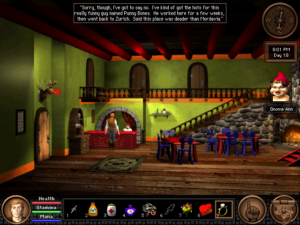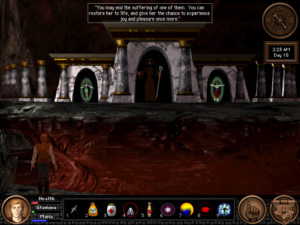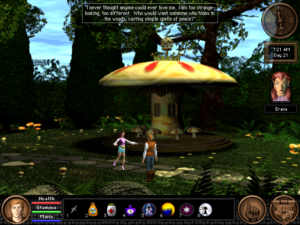QfG5: Thief
I’ve made a certain amount of progress with my new Thief character in Quest for Glory V. I haven’t yet started the Rite of Rulership, but I’ve joined the Thieves’ Guild, practiced my skills there, stocked up on equipment, and done a little housebreaking.
From the beginning, QfG‘s take on the Thief has been characterized by:
- A greater emphasis on adventure-game puzzlery, with lots of use of inventory items against obstacles that the Wizard overpowers with spells and the Fighter charges through with significant but sustainable loss of hit points
- Extra content, including houses that can be burglarized and assignments from the Thieves’ Guild. In QfG5, there’s a subplot about a contest to become Chief Thief, paralleling the contest for kingship in the main plot. (I wonder if it’s possible to hold both titles?)
- Additional opportunities to be a jerk.
My favorite example of the Thief being a jerk occurs in QfG3. There’s a musician in the open-air marketplace of the city where the game starts, with a bowl set out for coins from passers-by. Any character class can put a coin in the bowl, and earn a few points in the process. But the Thief has the option of stealing coins from the bowl instead, pretending to put a coin in to cover his movements. You get the same number of points for this.
Now, in that example, the consequences of being true to your profession are that you have slightly more cash, somewhat less Honor (making it basically impossible to become a Paladin), and the same score as you would otherwise. But other acts of theft in the games tend to just give you points that you can’t earn without antisocial behavior. The score in an adventure game is a non-diegetic reward mechanism. It’s a way for the author to reward the player for doing things the way the author wants them done, even in cases where there’s no benefit to it within the game. In particular, the QfG games use it as a way of rewarding you for staying in character. I’ve commented before on how the Fighter in QfG5 gets points for winning the Rites, while the Wizard does not. This tells me that the Fighter is more ambitious, more driven to win.
The thing is, I haven’t really seen this happening in QfG5. I’ve stolen some petty valuables from an empty house, but didn’t earn points for it. The game provides even greater opportunities for antisocial behavior than the previous games, mainly by adding the Pickpocket skill to your repertoire. You can try to rob everyone you meet, if you’re so inclined. You can even steal things that people would gladly give you for free if you asked them. But I have yet to see my score go up for such an action.
It’s seemed to me that the series toned down the crime over its run, which isn’t at all unusual for the morally questionable aspects of a series that’s supposed to be about a Hero. The Thieves’ Guild was a significant part of QfG1, a very minor part of QfG2, nonexistent in QfG3, and present but abandoned in QfG4. Opportunities for crime, while still present and rewarded in 1-4, lessened in number. In QfG5, we suddenly have a fully-functional Thieves’ Guild again, and there’s more opportunity for crime than ever before, but very little explicit motivation for it. Mind, this was a few years before GTA3 made it clear that crime for crime’s sake was viable in games. The original GTA had been released, though, so who knows, maybe there was some influence there.
 Comments(0)
Comments(0)

